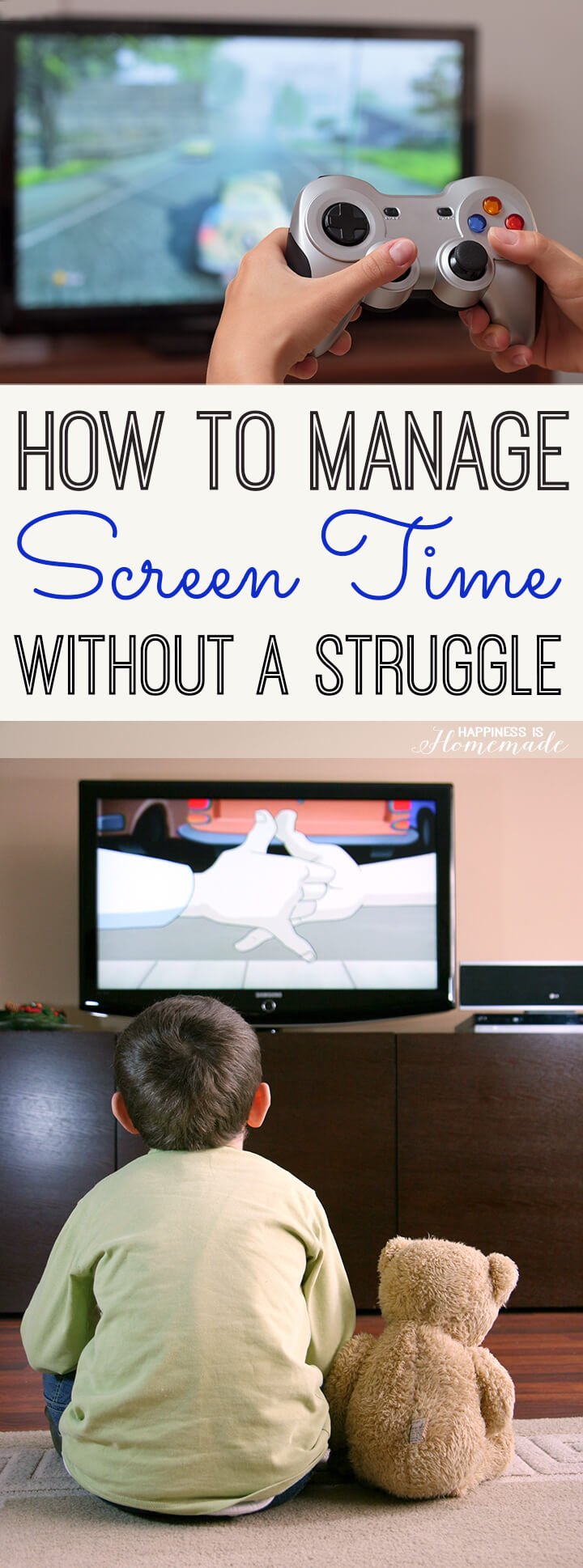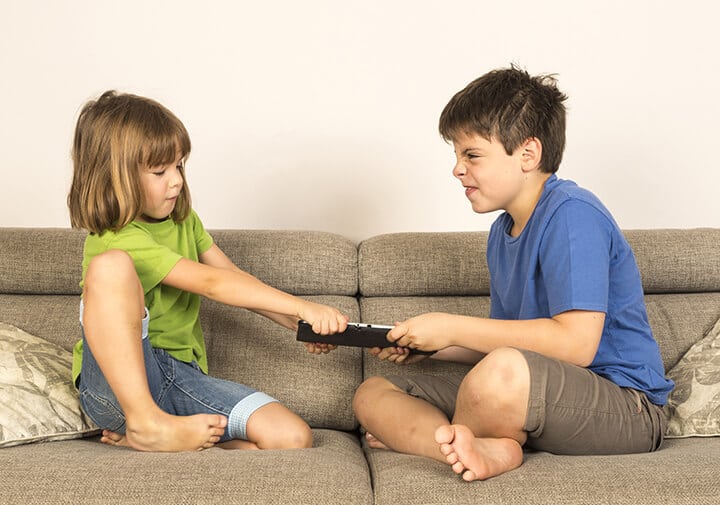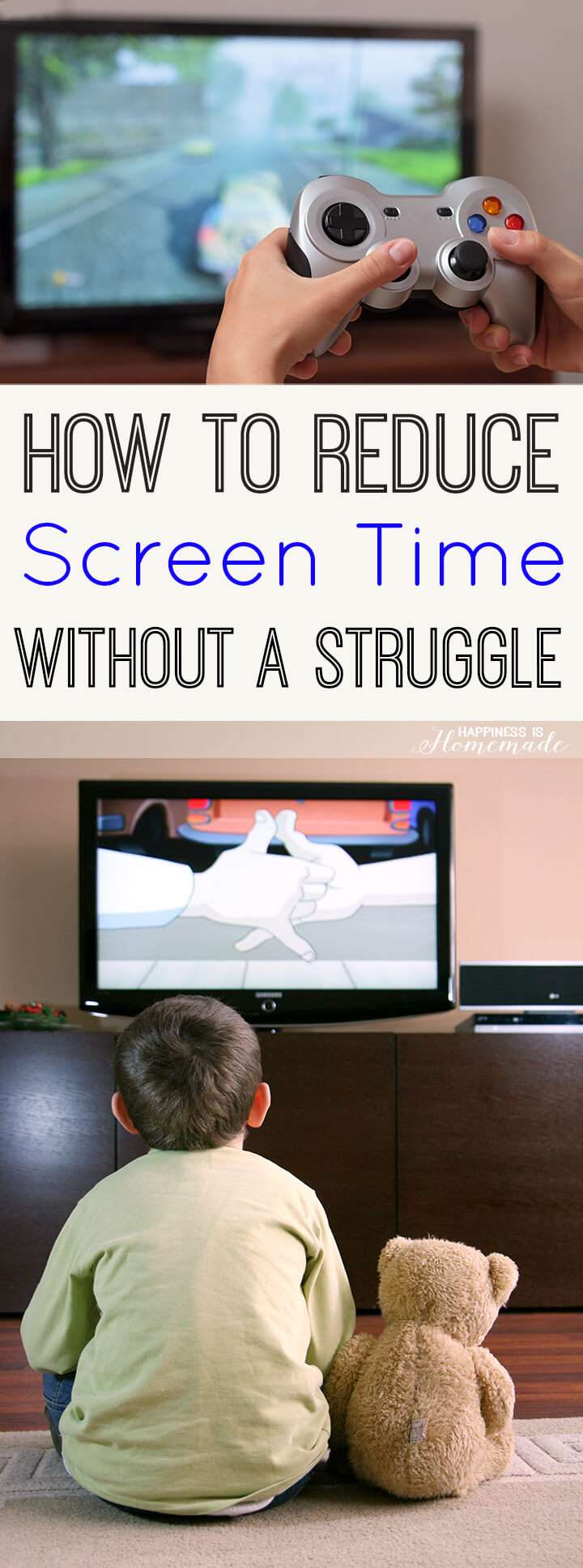Learn what we did to reduce our children’s screen time and discover our family’s system of earning and redeeming screen time within limits!
 It’s no secret that today’s children are getting FAR more screen time than my generation ever did. Little ones are spending an average of 4-5 hours watching television and playing video/computer games each day (according to survey results presented by the Nickelodeon network, the American Academy of Pediatrics, and Time magazine), and older children/teens are racking up a staggering 8-11 hours of media consumption daily. That’s an increase of almost 15% in the last three years alone! All of this screen time is forming addictive patterns in children, and science has proven that too much of it can cause damage to a child’s brain and behavior patterns. The American Academy of Pediatrics recommends that children get no more than 2 hours of screen time (that includes television and ALL devices!) each day. Clearly there is a huge discrepancy between the doctors’ recommendations and real life norms.
It’s no secret that today’s children are getting FAR more screen time than my generation ever did. Little ones are spending an average of 4-5 hours watching television and playing video/computer games each day (according to survey results presented by the Nickelodeon network, the American Academy of Pediatrics, and Time magazine), and older children/teens are racking up a staggering 8-11 hours of media consumption daily. That’s an increase of almost 15% in the last three years alone! All of this screen time is forming addictive patterns in children, and science has proven that too much of it can cause damage to a child’s brain and behavior patterns. The American Academy of Pediatrics recommends that children get no more than 2 hours of screen time (that includes television and ALL devices!) each day. Clearly there is a huge discrepancy between the doctors’ recommendations and real life norms.
After the first few weeks of our summer break, I noticed that my boys were starting to exceed the maximum recommended amount of screen time each day, and they were also growing increasingly cranky. Their behavior was crabby and snappy, their tempers were short, and they definitely weren’t being nice to each other. There were lots of arguments over insignificant things (“He crashed my Mario Kart!” “He blew up my Minecraft house!” “I want to watch Mythbusters, but HE won’t give me the remote! UGH!” Sound familiar?), and I decided that we needed to implement stricter screen time limits immediately.
We created a system in which our children are required to complete chores or other activities in order to earn their screen time (up to the recommended maximum of 2 hours per day), and it has been working SO well! I wanted to give our system a few months of real-life testing before I shared it here, and I have to say, there has been nothing else that motivates our children more than earning screen time! They definitely value their screen time now!
We started by talking to the kids and explaining the recommended screen time limits to them. I showed them a few articles about the damage that can be caused by too much screen time (so that they didn’t think I was making it up!). We talked about screen time alternatives and how there are plenty of health benefits from choosing other extracurricular activities.
The children weren’t thrilled about the idea of giving up their screen time, so we agreed that on Saturdays they could have one day of unlimited screen time…provided that ALL of their chores are done first! Of course, our Saturdays are often filled with sports games and practices, birthday parties and family activities, so “unlimited” doesn’t amount to much more than the traditional Saturday Morning Cartoon binge sessions that I used to do as a kid. It also gives the kids a sense of freedom and accomplishment from completing all of their weekly responsibilities. It does surpass the daily recommended amount of screen time for that day, but I think the benefits from imposing strict limits for the other six days outweighs this once-a-week treat.
I posted a list the following morning with the rules:
- No screen time until school is completed for the day (since we homeschool, the kids had a bad habit of watching a 30-minute television show during their lunch break). Screen time that is directly related to their school work is still allowed during school hours.
- Screen time can be earned in 15 minute increments by completing chores from their chore list or by completing an activity such as playing outdoors, reading a book, doing an art project, etc.
- There is a limit of 2 hours of screen time that can be earned daily with no more than 1 hour earned from participating in extracurricular activities. This means that they are required to complete chores from their list if they want to earn the full 2 hour maximum limit.
- No screen time after 7:00 p.m. (exceptions may be made for Family Movie Night on weekends).
- Screen time earned does NOT roll over to the next day. Each day starts anew.
A few examples from our chores/activities lists:
- Water the Garden = 15 minutes of screen time
- Sweep the Floors = 15 minutes
- Empty the Dishwasher = 30 minutes
- Read a Book for 30 Minutes = 15 minutes
- Play a Board Game for 30 Minutes = 15 minutes
(Note: I will be sharing a full printable version of our Screen Time Chore & Activity List on Sunday!) We ran into a few questions from the kids right away – What happens if someone is watching a television show and another kid is in the room? Do they both have to redeem their earned screen time? Or just the person who selected the show? What if someone is playing a video game and someone else is just watching? There were lots of grey areas, so we made a clear black-and-white decision:
We ran into a few questions from the kids right away – What happens if someone is watching a television show and another kid is in the room? Do they both have to redeem their earned screen time? Or just the person who selected the show? What if someone is playing a video game and someone else is just watching? There were lots of grey areas, so we made a clear black-and-white decision:
If your eyes are on the screen, you have to redeem your earned screen time.
We decided that if your eyes are on the screen, you must be willing to trade in your earned screen time. If a child doesn’t want to redeem their screen time to watch a show/game/movie that someone else has selected, he must go into another room while the screen is on. That may sound a bit harsh, but since we have televisions upstairs and downstairs in our home, it’s easy for us to separate the screen watchers from the non-screen watchers. With the screen time redemption rule firmly in place, we soon discovered that with limited amounts of screen time, our kids became far more picky about what they wanted to spend their screen time on!
So, how do we keep track of it all?
 I came up with a simple system that utilizes a glass jar for each child along with craft sticks that each represent 15 minutes of screen time.
I came up with a simple system that utilizes a glass jar for each child along with craft sticks that each represent 15 minutes of screen time.
When the child earns screen time, I place a craft stick into their jar. When they want to redeem their stick for screen time, they simply take the stick(s) out of the jar and give it back to me. We set a timer for the appropriate amount of time, and when the timer goes off, so does the screen. It’s really that simple (plus, using a timer means that they can’t argue with Mom about whether or not their time is really up!)!
Since we introduced this system, we have reduced our children’s screen time dramatically. Better yet, we have eliminated the screen time squabbles, and replaced them with the sounds of board games, art projects, and conversations between brothers that go something like “Do you want to watch Outrageous Acts of Science with me for 30 minutes or would you rather play Minecraft together for a little while?” That sounds like music to my ears!

Heidi Kundin has captivated the hearts of millions with her colorful and inspiring approach to crafting, celebrations, and family fun. With over 15 years of experience, Happiness is Homemade has become a must-visit destination for those seeking quick and easy creative ideas and last-minute solutions. Heidi’s warm personality shines through her posts, inviting readers to join her on a creative journey that’s fun, rewarding, and achievable. Heidi is also the author of Homemade Bath Bombs & More and DIY Tie-Dye.




